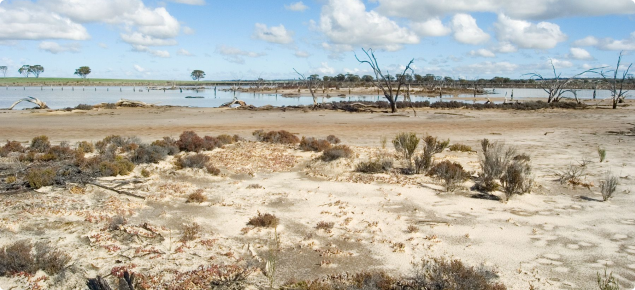The natural revegetation with no grazing option
This option assumes that there will be no grazing, and fencing is only required to exclude livestock from the area. All vegetation establishment is from surrounding or onsite species. These sites are often 'salt scalds', and may be primary salinity sites that have been extended by increased recharge and surface water flows.
This option suits the following conditions
- properties with no livestock
- severely to extremely saline and/or waterlogged sites and occassional inundation (fenced off from livestock, no fence with no livestock)
- areas of saline land that are too small to manage as a productive unit (fenced off from livestock, no fence with no livestock).
Benefits of this option
The benefits are:
- natural revegetation with local plants will usually occur at no cost
- the soil surface will stabilise
- there may be slightly less salt exported from the site
- the site is less susceptible to erosion
- visual amenity is improved
- saline habitat gradually improves.
Problems with this option
- recovery may be very slow
- salt movement offsite is unlikely to decrease
- there is no productive value.
Whole farm options
- Use shallow relief drains onsite to prevent inundation where possible.
- Use surface water management structures upslope to divert water to grassed waterways and a safe discharge.
- Use revegetation on less salt affected areas around the severely saline site.
Identifying suitable sites for this option
Common indicator species
Samphire (Tecticornia species) is the indicator plant for these sites. If samphire grows on the site, do not bother trying to revegetate with other plants. For more information see Samphires (Tecticornia species) for dryland salinity.
There may be other highly waterlogging and salt-tolerant plants present in slightly less saline patches and around the margins (eg. curly ryegrass, cotula and glasswort), and these species will colonise if the watertable falls or salinity decreases.
Revegetation of this class of land is gradual and episodic, and occurs naturally if grazing is excluded. Germination on bare areas can be improved by disc pitting or creating shallow furrows to trap seed and moisture. Samphire is not suited to grazing as the salt concentrations in the forage can reach 40%, and there are likely to be other, anti-nutritional factors.
Landscape niche
Watertables are between 1.0m deep in summer and to the soil surface in winter. The area may be inundated at times. Soil salinity is usually greater than ECe of 1600 milliSiemens per metre (mS/m), which is classed as severely to extremely saline.
Samphires can grow in soils that are more-or-less permanently waterlogged, and some species can withstand up to 6 months partial inundation.
Samphires growing at Wubin had soil ECe values of ~4000mS/m (slightly less than sea water concentration) at 0–25cm depth in spring.
Like many halophytes, samphire has its highest germination rates at low salinities. An experiment with T. pergranulata showed high rates of germination at 1400mS/m (25% of salinity of seawater), a 40% decrease in germination at 2700mS/m (50% of salinity of seawater), and no germination at 4100mS/m (75% of salinity of seawater) – despite adult plants easily persisting at those (and higher) salinity levels.
Climate
Samphires are well adapted to the temperature and rainfall conditions in almost all areas where dryland salinity occurs in southern Australia. Germination appears to be temperature responsive: optimal germination occurred with a day/night temp regime of 35/5°C.
Managing the site
Where livestock or native grazers are present, fence the site and control pest animals.
Fence above the area affected by salinity or at risk of becoming saline: this could be at the safe cropping boundary, or identified from an EM38 survey. We recommend planting salt tolerant shrubs or trees around the less salt-affected margins of these sites – this will help reduce salt movement from the site.
Resources
Short, DC and Colmer, TD, 1999, 'Salt tolerance in the halophyte Halosarcia pergranulata subsp. pergranulata', Annals of Botany, vol. 83, pp 207–213.
Rich, S, Ludwig, M, & Colmer, T, 2008, 'Photosynthesis in aquatic adventitious roots of the halophytic stem-succulent Tecticornia pergranulata (formerly Halosarcia pergranulata)', Plant, Cell and Environment, vol. 31, pp. 1007–16. 10.1111/j.1365–3040.2008.01813.x.
Pedersen, O, Vos, H & Colmer TD, 2006, 'Oxygen dynamics during submergence in the halophytic stem succulent Halosarcia pergranulata', Plant, Cell and Environment, vol. 29, pp. 1388–1399.
English, JP, 2004, Ecophysiology of salt- and waterlogging-tolerance in selected species of Halosarcia, doctoral thesis, School of Plant Biology, University of Western Australia, 331 pp.
Datson, B, 2005, Understanding Species Zonation of Samphires (Salicornieae) in the Goldfields of Western Australia, viewed 15 July 2019, http://www.actis.com.au/understanding_species_zonation_of_western_australian_samphires.pdf

